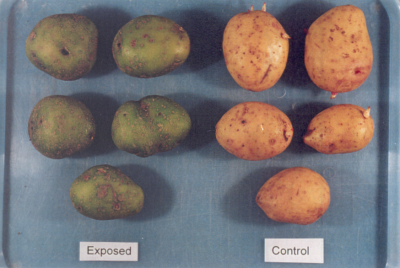
Tubers exposed to 500 µmoles photons m-2 s-1 or darkness for 14 days.
From October 1993 to June 1997 I studied for a PhD at The Nottingham Trent University. The title of my thesis was 'The Accumulation of Chlorophylls and Glycoalkaloids in Stored Tubers'.
Many of you will have noticed that when you've had your potatoes lying around for a bit they start to go green. This is due to the formation of chlorophyll (the green pigment found in plants) which is both tasteless and harmless. So why are greened potatoes considered inedible?
Concurrent with the greening process is an accumulation of toxic compounds known as steroidal glycoalkaloids. These are present in all parts of the potato plant, including tubers, at all times. However when the tuber is stressed, eg. bruising, wounding etc. it often shows an accumulation of glycoalkaliods. Similarly exposing the tuber to light will also increase glycoalkaloid content.
It is this latter effect that I studied.

Tubers exposed to 500 µmoles photons m-2 s-1 or darkness for 14 days.
Exposure to light causes potato tubers to green, due to the conversion of amyloplasts to chloroplasts, and accumulate toxic steroidal glycoalkaloids. The two major alkaloids, comprising 95% of the total (TGA) are α-solanine and α-chaconine. The consumption of potatoes with high TGA concentrations can cause illness and even death.
This study reports the successful adaptation of leaf Chl analysis methods to potato tubers. Existing HPLC methods of TGA analysis have been critically examined and a number of problems have been addressed. This combined with the use of a new SPE sorbent has resulted in sample recoveries of 93 and 99% for α-solanine and α-chaconine respectively. The reliability and reproducibility of these methods allow them to be used routinely.
Exposure of potato tubers to low PPFD at various temperatures has shown that even at a PPFD of 12 µmol photons m-2 s-1 tubers will accumulate detectable Chl within 48 hr. It has also been demonstrated that storage at 5°C will delay the onset of greening and greatly reduce its severity. Long term storage of tubers reduced the potential for light-induced accumulation of TGA but did not have any sof TGA but did not have any significant effect on Chl synthesis. The extent of both greening and TGA accumulation were dependant on cultivar choice. Artificial neural networks were used to model the data produced by these experiments and were shown to closely follow the actual data. These could then be used to predict tuber response to specific storage and light exposure conditions.
Preliminary studies on the physiology of greening demonstrated that the accumulation of Chl and TGA were not biosynthetically connected. Also, carotenoid composition during greening was shown to change markedly, including the synthesis of carotenoids not present in unexposed tubers and results indicated that greened tubers are capable of fixing atmospheric CO2.
© 1996-2002 Everard Edwards
This page was last updated Mon Jan 7 21:40:26 2002.